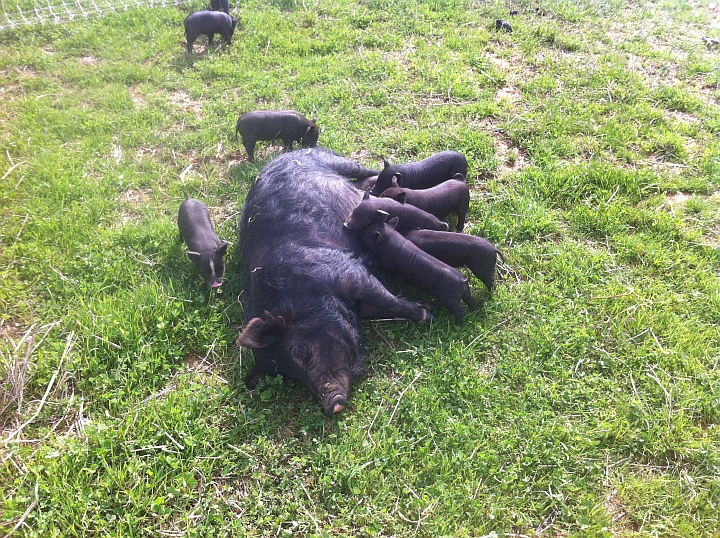Should we castrate our pigs? Ah, such a deceptively simple question. Castrating baby pigs sounds like not much fun. Especially since I would be the one wielding the knife. Unlike calves, lambs and goat kids, which can be castrated bloodlessly, pigs require surgical castration.
All things being equal, I would prefer not to castrate. It is our general philosophy that less intervention is better and animals should be allowed to express their natures. We do not disbud (de-horn) our goats nor clip chickens beaks and wings nor ring our hogs to keep them from rooting. We weigh that idea against our responsibility as stewards to ensure that our animals have a life as free of pain and suffering as possible. We make sure our animals have clean water, food, shelter and protection from predators. We treat animals that are sick. They are not wild animals, but neither are they pets. They are livestock, a category of animal that we are still learning how to think about. In the tension created by these two conflicting philosophies is where important management decisions are made.
But of course, there are complications. American Guinea Hogs are a slow growing breed. We plan to raise all our hogs to 18-24 months before they end up on your table. To prevent fighting, unintentional breeding and all manner of chaos, the girls and the boys would need to be kept separately and far, far apart. This is what we are doing now and with just 12 pigs, it is manageable. Over the past year of keeping livestock, we have learned that our pasture isn’t super-fantastic. We have a lot of work to do particularly improving the winter forage available, and until we do that, it is hard to justify further limiting our grazing options by spatially separating male and female feeder pigs.
More groups of pigs also means more expensive fence infrastructure, more time moving pigs around and more time doing daily chores. In short, more management. Our farm is plenty complicated already with over 30 vegetable crops, a small orchard, laying hens, meat chickens, and goats demanding our attention.
And then there is the issue of boar taint. I have studied many a heated discussion about taint on the two piggy Facebook groups that we are members of. Boar taint is an off-flavor of meat caused by certain hormones that produce chemicals stored in fat. Taint has the terrifying potential to turn valuable, gourmet meat into a lot of very expensive dog food. About 75% of people can detect boar taint. Reports of the prevalence of boar taint range from 1% to 30% of boars depending on the study.
Both nature and nurture are responsible for the presence of taint. Allegedly, pastured pigs are less likely to have taint than confinement animals. Boars raised away from females are also less likely to have taint. Some lines of pigs just don’t have it, and some breeds have a higher prevalence than others. Guinea Hogs are supposed to be taint-free, but there are people who will tell you they have tasted taint in Guinea Hog pork. Of particular concern for us is that we are raising our pigs twice to three times as long as is typical for pastured pork. Some farmers are intentionally breeding taint-free lines of pigs by testing their boars for taint which is the direction we would like to head.
Fear of the unknown is powerful motivation. Castration is cheap insurance against boar taint, which is one reason why so many people do it. Until we have a better understanding of the genetics of our particular pigs I certainly like the idea of hedging our bets. Better than losing $500-$600 on a full grown pig that is unfit to eat.
More important for us, however, is the management issue. Keeping male and female pigs separate would be too complicated for us at this point in time. Maybe in the future raising intact males will make more sense. For now, we have decided to cut.



